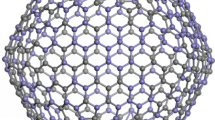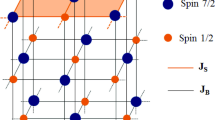Abstract
In this work, the magnetic properties of superparamagnetic iron oxide nanoparticles (SPIONs) submitted to an external magnetic field are studied using a Metropolis algorithm. The influence on the M(B) curves of the size distribution of the nanoparticles, of uniaxial anisotropy, and of dipolar interaction between the cores are examined, as well as the influence of drying the samples under a zero or non-zero magnetic field. It is shown that the anisotropy impacts the shape of the magnetization curves, which then deviate from a pure Langevin behaviour, whereas the dipolar interaction has no influence on the curves at 300 K for small particles (with a radius of \(3\,\hbox {nm}\)). The fitting of the magnetization curves of particles with magnetic anisotropy to a Langevin model (including a size distribution of the particles) can then lead to erroneous values of the distribution parameters. The simulation results are qualitatively compared to experimental results obtained for iron oxide nanoparticles (with a \(3.21\, \hbox {nm}\) median radius).
Graphic Abstract









Similar content being viewed by others
Data availability statement
All data, and the source code of the simulations and fits, are accessible upon request to the corresponding author.
References
A.S. Arbab, J.A. Frank, Cellular mri and its role in stem cell therapy. Regener. Med. 3(2), 199–215 (2008)
J. Borgert, J.D. Schmidt, I. Schmale, J. Rahmer, C. Bontus, B. Gleich, B. David, R. Eckart, O. Woywode, J. Weizenecker, J. Schnorr, M. Taupitz, J. Haegele, F.M. Vogt, J. Barkhausen, Fundamentals and applications of magnetic particle imaging. J. Cardiovasc. Comput. Tomogr. 6(15), 149–153 (2012)
W.F Jr. Brown, Thermal fluctuations of a single-domain particle. Phys. Rev. 130(5), 1677–1686 (1963)
J.W.M. Bulte, In vivo mri cell tracking: clinical studies. Am. J. Roentgenol. 193, 314–325 (2009)
R.W. Chantrell, N. Walmsley, J. Gore, M. Maylin, Calculations of the susceptibility of interacting superparamagnetic particles. Phys. Rev. B 63(2), 0244101–02441014 (2000)
D.A. Dimitrov, G.M. Wysin, Magnetic properties of superparamagnetic particles by a monte carlo method. Phys. Rev. B 54, 9237 (1996)
J.R. Dunn, M. Fuller, J. Zoeger, J. Dobson, F. Heller, J. Hammann, E. Caine, B.M. Moskowitz, Magnetic material in the human hippocampus. Brain Res. Bull. 36(2), 149–153 (1995)
J. Fock, L.K. Bogart, D. González-Alonso, J.I. Espeso, M.F. Hansen, M. Varón, C. Frandsen, Q.A. Pankhurst, On the ‘centre of gravity’ method for measuring the composition of magnetite/maghemite mixtures, or the stoichiometry of magnetite-maghemite solid solutions, via 57fe mössbauer spectroscopy. J. Phys. D: Appl. Phys 50(26), 265005 (2017)
J. García-Otero, M. Porto, J. Rivas, A. Bunde, Influence of dipolar interaction on magnetic properties of ultrafine ferromagnetic particles. Phys. Rev. Lett. 84(1), 167–170 (2000)
A. Gelman, J.B. Carlin, H.S. Stern, D.B. Dunson, A. Vehtari, D.B. Rubin, Computationally efficient Markov chain simulation, chapter 12, 3rd edn. (CRC Press, Boca Raton, 2014), pp. 293–310
B. Gleich, J. Weizenecker, Tomographic imaging using the nonlinear response of magnetic particles. Nature 435, 1214–1217 (2005)
J.-M. Greneche, in The contribution of 57fe mössbauer spectrometry to investigate magnetic nanomaterials. Mössbauer Spectroscopy, chapter 4, 1st edn. (Springer, Berlin, Heidelberg, 2013), pp. 204–205
D. Henrard, Q.L. Vuong, S. Delangre, X. Valentini, D. Nonclercq, M.F. Gonon, Y. Gossuin, Monitoring of superparamagnetic particle sizes in the langevin law regime. J. Nanomater. 64092101–64092109, 2019 (2019)
J.M. Hill, A.J. Dick, V.K. Raman, R.B. Thompson, Z.-X. Yu, K. Allison Hinds, Breno S.S. Pessanha, Michael A. Guttman, Timothy R. Varney, Bradley J. Martin, Cynthia E. Dunbar, Elliot R. McVeigh, Robert J. Lederman, Serial cardiac magnetic resonance imaging of injected mesenchymal stem cells. Circulation 108, 1009–1014 (2003)
U. Himmelreich, T. Dresselaers, Cell labeling and tracking for experimental models using magnetic resonance imaging. Methods 48, 112–124 (2009)
C.E. Hoppe, F. Rivadulla, M. Arturo López-Quintela, M. Carmen Buján, J. Rivas, D. Serantes, D. Baldomir, Effect of submicrometer clustering on the magnetic properties of free-standing superparamagnetic nanocomposites. J. Phys. Chem. C 112(34), 13099–13103 (2008)
C. Hughes, J. Galea-Lauri, F. Farzaneh, D. Darling, Streptavidin paramagnetic particles provide a choice of three affinity-based capture and magnetic concentration strategies for retroviral vectors. Mol. Ther. 3(4), 623–629 (2001)
P. Ilg, M. Kröger, Dynamics of interacting magnetic nanoparticles: effective behavior from competition between brownian and néel relaxation. Phys. Chem. Chem. Phys. 22, 22244–22259 (2020)
A.O. Ivanov, S.S. Kantorovich, E.N. Reznikov, C. Holm, A.F. Pshenichnikov, A.V. Lebedev, A. Chremos, P.J. Camp, Magnetic properties of polydisperse ferrofluids: a critical comparison between experiment, theory, and computer simulation. Phys. Rev. E 75, 061405 (2007)
D. Kechrakos, K.N. Trohidou, Magnetic properties of dipolar interacting single-domain particles. Phys. Rev. B 58(18), 12169–12178 (1998)
S.J. Kemp, R. Matthew Ferguson, A.P. Khandhar, K.M. Krishnan, Monodisperse magnetite nanoparticles with nearly ideal saturation magnetization. RSC Adv. 6, 77452–77464 (2016)
P. Langevin, Sur la théorie du magnétisme. Journal de physique théorique et appliquée 4(1), 678–693 (1905)
J. Londoño-Navarro, J.C. Riaño-Rojas, E. Restrepo-Parra, Competition between anisotropy and dipolar interaction in multicore nanoparticles: Monte carlo simulation. DYNA 82(194), 66–71 (2015)
I.T. Lucas, S. Durand-Vidal, E. Dubois, J. Chevalet, P. Turq, Surface charge density of maghemite nanoparticles: role of electrostatics in the proton exchange. J Phys. Chem. 111(50), 18568–18576 (2007)
M. Lévy, F. Gazeau, J.-C. Bacri, C. Wilhelm, M. Devaud, Modeling magnetic nanoparticle dipole-dipole interactions inside living cells. Phys. Rev. B 84(7), 075480-1–075480-11 (2011)
M. Lévy, C. Wilhelm, M. Devaud, P. Levitz, F. Gazeau, How cellular processing of superparamagnetic nanoparticles affects their magnetic behavior and nmr relaxivity. Contrast Media Mol. Imaging 7, 373–383 (2012)
M. Lévy, C. Wilhelm, N. Luciani, V. Deveaux, F. Gendron, Alain Luciani, Martin Devaud, Florence Gazeau, Nanomagnetism reveals the intracellular clustering of iron oxide nanoparticles in the organism. Nanoscale 3, 4402–4410 (2011)
H. Mamiya, H. Fukumoto, J.L.C. Huaman, K. Suzuki, H. Miyamura, J. Balachandran, Estimation of magnetic anisotropy of individual magnetite nanoparticles for magnetic hyperthermia. ACS Nano 14(7), 8421–8432 (2020)
N. Metropolis, A.W. Rosenbluth, M.N. Rosenbluth, A.H. Teller, E. Teller, Equation of state calculations by fast computing machines. J. Chem. Phys. 21, 1087–1092 (1953)
O. Mykhaylyk, T. Sobisch, I. Almstätter, Y. Sanchez-Antequera, S. Brandt, M. Anton, M. Döblinger, D. Eberbeck, M. Settles, R. Braren, D. Lerche, C. Plank, Silica-iron oxide magnetic nanoparticles modified for gene delivery: a search for optimum and quantitative criteria. Pharmac. Res. 29(5), 1344–1365 (2012)
T. Neuberger, B. Schöpf, H. Hofmann, M. Hofmann, B. von Rechenberg, Superparamagnetic nanoparticles for biomedical applications: possibilities and limitations of a new drug delivery system. J. Magn. Magn. Mater. 293, 483–496 (2005)
L. Néel, Theory of the magnetic after-effect in ferromagnetics in the form of small particles, with applications to baked clays, chapter A69. (Gordon and Breach Science Publishers, 1988), pp. 407–427
N. Ortiz-Gordoy, D.G. Agredo-Diaz, A.O. Garzón-Posada, C.A. Parra Vargas, D.A. Landínez Téllez, J. Roa-Rojas, A facile method to produce magnetic nanoparticles and its influence on their magnetic and physical properties. Mater. Lett. 293, 129700 (2021)
J.M. Perez, F. Joseph Simeone, Y. Saeki, L. Josephson, R. Weissleder, Viral-induced self-assembly of magnetic nanoparticles allows the detection of viral particles in biological media. J. Am. Chem. Soc. 125, 10192–10193 (2003)
O. Petracic, Superparamagnetic nanoparticle ensembles. Superlattices Microstruct. 47, 569–578 (2010)
C. Plank, O. Zelphati, O. Mykhaylyk, Magnetically enhanced nucleic acid delivery ten years of magnetofection—progress and prospects. Adv. Drug Deliv. Rev. 63, 1300–1331 (2011)
E.A. Périgo, G. Hemery, O. Sandre, D. Ortega, E. Garaio, F. Plazaola, F.J. Teran, Fundamentals and advances in magnetic hyperthermia. Appl. Phys. Rev. 2(4), 041302 (2015)
R. Qiao, C. Yang, M. Gao, Superparamagnetic iron oxide nanoparticles: from preparations to in vivo mri applications. J. Mater. Chem. 19, 6274–6293 (2009)
M. Respaud, Magnetization process of noninteracting ferromagnetic cobalt nanoparticles in the superparamagnetic regime: deviation from langevin law. J. Appl. Phys. 86(1), 556–561 (1999)
V.Y. Rudyak, S.L. Krasnolutskii, Dependence of the viscosity of nanofluids on nanoparticle size and material. Phys. Lett. A 378(26), 1845–1849 (2014)
V. Russier, C. de Montferrand, Y. Lalatonne, L. Motte, Size and polydispersity effect on the magnetization of densely packed magnetic nanoparticles. J. Appl. Phys. 112(7), 0739261–07392611 (2012)
V. Schaller, G. Wahnström, A. Sanz-Velasco, P. Enoksson, C. Johansson, Monte carlo simulation of magnetic multi-core nanoparticles. J. Magn. Magn. Mater. 321, 1400–1403 (2009)
M. Shahsavari Alavijeh, M.S. Bani, I. Rad, S. Hatamie, M.S. Zomorod, M. Haghpanahi, Antibacterial properties of ferrimagnetic and superparamagnetic nanoparticles: a comparative study. J. Mech. Sci. Technol. 35(2), 815–821 (2021)
M. Shliomis, Effective viscosity of magnetic suspensions. Sov. Phys. JETP 34, 1291–1294 (1972)
F. Tournus, A. Tamion, Magnetic susceptibility curves of a nanoparticle assembly ii. Simulation and analysis of zfc/fc curves in the case of a magnetic anisotropy energy distribution. J. Magn. Magn. Mater. 323, 1118–1127 (2011)
K. Trohidou and M. Vasilakaki. Monte Carlo Studies of Magnetic Nanoparticles, chapter 20. (IntechOpen, New York, 2011), pp 513–538
F. Vernay, Z. Sabsabi, O. Iglesias, H. Kachkachi, Surface effects on the magnetic behavior of nanoparticle assemblies. Phys. Rev. B 521, 012010 (2012)
Viscosity of chloroform. https://wiki.anton-paar.com/en/chloroform/. Accessed 15 Nov 2022
Viscosity of toluene. https://wiki.anton-paar.com/en/toluene/. Accessed 15 Nov 2022
Q.L. Vuong, P. Gillis, A. Roch, Y. Gossuin, Magnetic resonance relaxation induced by superparamagnetic particles used as contrast agents in magnetic resonance imaging: a theoretical review. WIREs Nanomed. Nanobiotechnol. 4 (2017)
L. Wang, J. Ding, H.Z. Kong, Y. Li, Y.P. Feng, Monte carlo simulation of a cluster system with strong interaction and random anisotropy. Phys. Rev. B 64, 214410 (2011)
F. Wiekhorst, U. Steinhoff, D. Eberbeck, L. Trahms, Magnetorelaxometry assisting biomedical applications of magnetic nanoparticles. Pharm. Res. 29, 1189–1202 (2012)
C. Wilhelm, F. Gazeau, Universal cell labelling with anionic magnetic nanoparticles. Biomaterials 29, 3161–3174 (2008)
R.C. Woodward, J. Heeris, T.GSt. Pierre, M. Saunders, E.P. Gilbert, M. Rutnakornpituk, Q. Zhang, S. Riffle, A comparison of methods for the measurement of the particle-size distribution of magnetic nanoparticles. J. Appl. Crystallogr. 40, s495–s500 (2007)
M. Zhongquan, D. Chen, Z. He, Equilibrium magnetic properties of dipolar interacting ferromagnetic nanoparticles. J. Magn. Magn. Mater. 320, 2335–2338 (2008)
Acknowledgements
The authors would like to thank Sophie Laurent from the University of Mons for the access to the Dynamic Light Scattering equipment. Computational resources have been provided by the Consortium des Équipements de Calcul Intensif (CÉCI), funded by the Fonds de la Recherche Scientifique de Belgique (F.R.S.-FNRS) under Grant No. 2.5020.11 and by the Walloon Region.
Funding
This work was supported by University of Mons (UMONS).
Author information
Authors and Affiliations
Contributions
ÉM: methodology, software, validation, investigation, formal analysis, data curation, writing, and visualization. SB and SK: TEM imaging of the experimental sample. YG: conceptualization, methodology, data curation, resources, and supervision. QLV: conceptualization, methodology, software, validation, and supervision.
Corresponding author
Ethics declarations
Conflict of interest
The authors declare no competing interest.
Supplementary Information
Below is the link to the electronic supplementary material.
Rights and permissions
Springer Nature or its licensor (e.g. a society or other partner) holds exclusive rights to this article under a publishing agreement with the author(s) or other rightsholder(s); author self-archiving of the accepted manuscript version of this article is solely governed by the terms of such publishing agreement and applicable law.
About this article
Cite this article
Martin, É., Gossuin, Y., Bals, S. et al. Monte Carlo simulations of the magnetic behaviour of iron oxide nanoparticle ensembles: taking size dispersion, particle anisotropy, and dipolar interactions into account. Eur. Phys. J. B 95, 201 (2022). https://doi.org/10.1140/epjb/s10051-022-00468-w
Received:
Accepted:
Published:
DOI: https://doi.org/10.1140/epjb/s10051-022-00468-w




